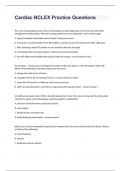summary of all articles on supply chain strategy 325240-m-6
1. Definition and Importance of Supply Chain Strategy
Supply Chain Strategy: Refers to a comprehensive plan designed to achieve competitive
advantage by effectively managing the flow of goods, services, and information from
suppliers to customers.
Importance: Enhances efficiency, reduces costs, improves customer satisfaction, and
fosters innovation.
2. Types of Supply Chain Strategies
Lean Supply Chain: Focuses on reducing waste and improving efficiency.
Agile Supply Chain: Emphasizes flexibility and responsiveness to changing market
demands.
Hybrid Supply Chain: Combines lean and agile strategies to balance efficiency and
flexibility.
Resilient Supply Chain: Prioritizes risk management and the ability to recover from
disruptions.
3. Components of Supply Chain Strategy
Supplier Management: Strategies for selecting, managing, and collaborating with
suppliers.
Inventory Management: Techniques for optimizing inventory levels to meet demand
while minimizing costs.
Logistics and Distribution: Efficient management of transportation, warehousing, and
distribution channels.
Technology Integration: Use of advanced technologies like IoT, AI, and blockchain to
enhance supply chain operations.
Sustainability: Incorporating eco-friendly practices to minimize environmental impact.
4. Developing a Supply Chain Strategy
Market Analysis: Understanding market demands, competition, and customer needs.
Capacity Planning: Ensuring that the supply chain can meet future demands.
Performance Metrics: Establishing key performance indicators (KPIs) to measure
success.
Collaboration and Partnerships: Building strong relationships with partners to improve
overall efficiency and innovation.
5. Challenges in Supply Chain Strategy
Globalization: Managing supply chains across different countries with varying
regulations and market conditions.
, Disruptions: Handling unexpected events like natural disasters, geopolitical issues, and
pandemics.
Technology Adoption: Integrating new technologies while ensuring data security and
system interoperability.
Sustainability Pressure: Balancing cost-efficiency with sustainable practices.
6. Case Studies and Best Practices
Successful Implementations: Examples of companies that have effectively implemented
supply chain strategies, such as Toyota’s lean manufacturing and Amazon’s agile supply
chain.
Lessons Learned: Insights from failed strategies or challenges faced by companies and
how they overcame them.
7. Future Trends in Supply Chain Strategy
Digital Transformation: Increasing reliance on digital tools and data analytics.
AI and Automation: Growing use of artificial intelligence and robotics in supply chain
management.
Circular Supply Chains: Moving towards more sustainable and circular supply chain
models.
Customer-Centric Models: Shifting focus towards enhancing customer experience and
customization.
Key Articles and Authors
"The Triple-A Supply Chain" by Hau L. Lee: Discusses the importance of agility,
adaptability, and alignment in supply chains.
"Competing in a Flat World" by Victor Fung, William Fung, and Yoram (Jerry)
Wind: Explores global supply chain management and strategies for success in a
globalized economy.
"Supply Chain Management: Strategy, Planning, and Operation" by Sunil Chopra
and Peter Meindl: A comprehensive guide on various aspects of supply chain strategy
and management.
Conclusion
Effective supply chain strategy is critical for businesses to thrive in a competitive and rapidly
changing global market. By understanding and implementing the right strategies, companies can
achieve significant operational efficiencies, reduce costs, and deliver superior customer value.
The field continues to evolve with advancements in technology and growing emphasis on
sustainability and resilience.
This summary encapsulates the core themes and ideas from numerous articles on supply chain
strategy, providing a holistic view of the subject.
, 8. Impact of Digital Technologies on Supply Chain Strategy
IoT (Internet of Things): Enables real-time tracking and monitoring of goods,
improving transparency and reducing delays.
Blockchain: Enhances security and traceability in the supply chain, reducing fraud and
errors.
Big Data Analytics: Provides insights through data analysis, enabling better forecasting
and decision-making.
Artificial Intelligence (AI): Automates processes, optimizes routes, and predicts
maintenance needs, increasing overall efficiency.
9. Sustainability in Supply Chain Strategy
Green Supply Chains: Focuses on reducing carbon footprints, using renewable energy,
and minimizing waste.
Circular Economy: Emphasizes reusing, recycling, and repurposing materials to extend
product lifecycles.
Ethical Sourcing: Ensures that materials are sourced in a way that respects human rights
and environmental standards.
Corporate Social Responsibility (CSR): Incorporates social and environmental
concerns into business operations and interactions with stakeholders.
10. Risk Management in Supply Chain Strategy
Identifying Risks: Mapping out potential risks in the supply chain, such as natural
disasters, political instability, and supplier failures.
Risk Mitigation Strategies: Developing contingency plans, diversifying suppliers, and
maintaining buffer stocks.
Insurance and Financial Instruments: Using tools like insurance and hedging to
protect against financial losses.
Crisis Management: Establishing protocols for quickly responding to and recovering
from disruptions.
11. Global Supply Chain Strategy
Outsourcing and Offshoring: Balancing cost advantages with potential risks and quality
issues.
Nearshoring and Reshoring: Moving production closer to the end market to reduce
transportation costs and improve responsiveness.
Trade Agreements and Regulations: Navigating international trade laws, tariffs, and
compliance requirements.
Cultural Considerations: Managing cross-cultural differences in global supply chains to
ensure effective communication and collaboration.



